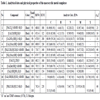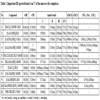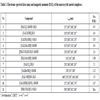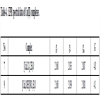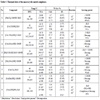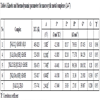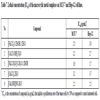- Home
- About Journals
-
Information for Authors/ReviewersEditorial Policies
Publication Fee
Publication Cycle - Process Flowchart
Online Manuscript Submission and Tracking System
Publishing Ethics and Rectitude
Authorship
Author Benefits
Reviewer Guidelines
Guest Editor Guidelines
Peer Review Workflow
Quick Track Option
Copyediting Services
Bentham Open Membership
Bentham Open Advisory Board
Archiving Policies
Fabricating and Stating False Information
Post Publication Discussions and Corrections
Editorial Management
Advertise With Us
Funding Agencies
Rate List
Kudos
General FAQs
Special Fee Waivers and Discounts
- Contact
- Help
- About Us
- Search

Open Chemistry Journal
(Discontinued)
ISSN: 1874-8422 ― Volume 8, 2021
Novel (N4) Macrocyclic Metal Complexes: Synthesis, Characterization, Spectral Studies and Anticancer Activity
Hanaa A. El-Boraey1, *, Ohyla A. EL-Gammal2
Abstract
Introduction:
A new series of mononuclear Fe(II), Co(II), Ni(II), Cu(II) and Pd(II) complexes correspond to tetradentate macrocyclic nitrogen ligand i.e. naphthyl-3,4:10,11-dibenzo,7-methylene,8-methyl,6-phenyl-1,5,9,13-tetraazacyclohexadecane-5,8-diene-2,12-dione metal(II) complexes, have been synthesized by the template condensation reaction.
Methods:
The complexes have been characterized by elemental analysis, spectral (IR, UV–Vis, and ESR, molar conductivity, and magnetic as well as thermal analysis measurements.
Results:
On the basis of above studies, an octahedral geometry has been proposed for all complexes except Cu(II) nitrate complex that adopt square pyramidal geometry, and square planar geometry for Pd(II) chloride complex, respectively.
Conclusion:
The thermal behavior and the kinetic parameters of degradation were determined using Coats-Redfern and Horowitz-Metzger methods. Moreover, the in vitro antitumor activity of the some synthesized complexes against human breast and human hepatocarcinoma cell lines (MCF-7) and (HePG2), respectively has been studied.
Article Information
Identifiers and Pagination:
Year: 2018Volume: 5
First Page: 51
Last Page: 63
Publisher Id: CHEM-5-51
DOI: 10.2174/1874842201805010051
Article History:
Received Date: 20/02/2017Revision Received Date: 10/05/2018
Acceptance Date: 31/05/2018
Electronic publication date: 29/06/2018
Collection year: 2018
open-access license: This is an open access article distributed under the terms of the Creative Commons Attribution 4.0 International Public License (CC-BY 4.0), a copy of which is available at: https://creativecommons.org/licenses/by/4.0/legalcode. This license permits unrestricted use, distribution, and reproduction in any medium, provided the original author and source are credited.
* Address correspondence to this author at the Department of Chemistry, Faculty of Science, Menoufia University, Shebin El- Kom, Egypt; Tel: +20 111 7532777; Fax: +20 48 2235689.; E-mail: helboraey@yahoo.com
| Open Peer Review Details | |||
|---|---|---|---|
| Manuscript submitted on 20-02-2017 |
Original Manuscript | Novel (N4) Macrocyclic Metal Complexes: Synthesis, Characterization, Spectral Studies and Anticancer Activity | |
1. INTRODUCTION
The interest in the study of synthetic macrocyclic compounds is a very integral part of coordination chemistry due to their presence in many biological naturally occurring metal complexes. The field of macrocyclic metal chemistry is developing very rapidly because of its applications and the great importance in the coordination chemistry [1Montero-Vázquez, E.F.; Martínez-Martínez, F.J.; Padilla-Martínez, I.I.; Carvajal-García, M.A.; Hernández-Díaz, J.H. New bis-oxalamides
from trans-1,2-diaminocyclohexane. ARKOVIC (V), 2008, pp. 276-282.-12Chandra, S.; Gupta, L.K. Spectroscopic approach in characterization of chromium(III), manganese(II), iron(III) and copper(II) complexes with a nitrogen donor tetradentate, 14-membered azamacrocyclic ligand. Spectrochim. Acta A, 2005, 61, 2139-2144.
[http://dx.doi.org/10.1016/j.saa.2004.06.060] ]. The importance of macrocyclic systems in chemistry is attributed to their many industrial applications and in a number of biological processes such as photosynthesis, catalytic properties, dioxygen transport and their potential application to extract specific metals [9Izatt, R.M.; Bradshaw, J.S.; Nielsen, S.A.; Lamb, J.D.; Christensen, J.J.; Sen, D. Thermodynamic and kinetic data for cation-macrocycle interaction. Chem. Rev., 1985, 85, 271-339.
[http://dx.doi.org/10.1021/cr00068a003] , 10Temel, H.; Ilhan, S. Prepared and characterization of new macrocyclic Schiff bases and their binuclear copper complexes. Spectrochim. Acta A Mol. Biomol. Spectrosc., 2008, 69(3), 896-903.
[http://dx.doi.org/10.1016/j.saa.2007.05.041] [PMID: 17604212] ]. The selectivity of the macrocyclic ligands that contain combination of Oxo (O), Aza (N), Phospha (P) and Sulpha (S) for the extraction of metal ions depends on the ligand flexibility, nature of the ligand backbone, the cavity size of the macrocyclic core, nature and number of donor atoms in addition to their relative position in the macrocyclic ligands and the pendant coordinating arms attached to the ligand [8Fernández-Fernández, M.C.; Bastida, R.; Macías, A.; Valencia, L.; Pérez-Lourido, P. Different nuclearities of M(II) nitrate complexes (M = Co, Ni, Cu and Cd) with a tetrapyridyl pendant-armed hexaazamacrocyclic ligand. Polyhedron, 2006, 25, 783-792.
[http://dx.doi.org/10.1016/j.poly.2005.07.045] , 10Temel, H.; Ilhan, S. Prepared and characterization of new macrocyclic Schiff bases and their binuclear copper complexes. Spectrochim. Acta A Mol. Biomol. Spectrosc., 2008, 69(3), 896-903.
[http://dx.doi.org/10.1016/j.saa.2007.05.041] [PMID: 17604212] ]. Complexes with poly -azamacrocyclic ligands have attracted a focus of scientific attention [7Chandra, S.; Gupta, L.K.; Jain, D. Spectroscopic studies on Mn(II), Co(II), Ni(II), and Cu(II) complexes with N-donor tetradentate (N4) macrocyclic ligand derived from ethylcinnamate moiety. Spectrochim. Acta A Mol. Biomol. Spectrosc., 2004, 60(10), 2411-2417.
[http://dx.doi.org/10.1016/j.saa.2003.12.016] [PMID: 15249033] , 13EL-Boraey. H.A.; Emam, S.M.; Tolan, D.A.; El-Nahas, A.M.; Structural studies and anticancer activity of a novel (N6O4) macrocyclic ligand and its Cu(II) complexes. Spectrochim. Acta A, 2011, 78, 360-370.
[http://dx.doi.org/10.1016/j.saa.2010.10.021] ]. Recently, much attention has been paid to macrocyclic compounds containing amide groups [14El-Boraey, H.A.; Serag El-Din, A.A. Transition metal complexes of a new 15-membered [N5] penta-azamacrocyclic ligand with their spectral and anticancer studies. Spectrochim. Acta A Mol. Biomol. Spectrosc., 2014, 132, 663-671.
[http://dx.doi.org/10.1016/j.saa.2014.05.018] [PMID: 24892547] , 15EL-Boraey. H.A.; EL-Gammal, O.A.; New 15-membered tetraaza (N4) macrocyclic ligand and its transition metal complexes: spectral, magnetic, thermal and anticancer activity. Spectrochim. Acta A, 2015, 138, 533-562.
[http://dx.doi.org/10.1016/j.saa.2014.11.015] ]. Macrocyclic amides have applications in elector fluorescence devices (EL) and homogeneous catalysis [16Harinath, Y.; Kumar Reddy, D.H.; Kumar, B.N.; Apparao, Ch.; Seshaiah, K. Synthesis, spectral characterization and antioxidant activity studies of a bidentate Schiff base, 5-methyl thiophene-2-carboxaldehyde-carbohydrazone and its Cd(II), Cu(II), Ni(II) and Zn(II) complexes. Spectrochim. Acta A Mol. Biomol. Spectrosc., 2013, 101, 264-272.
[http://dx.doi.org/10.1016/j.saa.2012.09.085] [PMID: 23103468] ]. The template condensation for the preparation of the macrocyclic ligands often offers selective routes towards products that are not formed in the absence of metal ions [17Kang, S.G.; Song, J.; Jeong, J.H. Synthesis and characterization of new unsaturated macrobicyclic and bis(macrocyclic) copper(II) complexes containing N–CH2–N linkages. Inorg. Chim. Acta, 2004, 357, 605-610.
[http://dx.doi.org/10.1016/j.ica.2003.06.006] ]. The template condensation methods lie at the heart of macrocyclic chemistry [18Curtis, N.F. Macrocyclic coordination compounds formed by condensation of metal-amine complexes with aliphatic carbonyl compounds. Coord. Chem. Rev., 1968, 3, 3-47.
[http://dx.doi.org/10.1016/S0010-8545(00)80104-6] ]. Therefore, if the ligand yield is low, macrocyclic complexes have been widely isolated using the template reactions [19Niasari, M.S.; Daver, F. New 14-membered octaazamacrocyclic complexes: Synthesis, spectral, antibacterial and antifungal studies. Inorg. Chem. Commun., 2006, 9, 175-179.]. The transition metal ions are used as the templating agent [20Prasad, R.N.; Gupta, S.; Jangir, S. J. Indian Chem. Soc., 2007, 84, 1191-1194.]. The metal ions direct the reaction preferentially towards cyclic rather than oligomeric or polymeric products [21Khan, T.A.; Hasan, S.S.; Mohamed, A.K.; Shakir, M. Template synthesis and spectroscopic studies of 13 membered oxotetraaza macrocyclic complexes. Indian J. Chem., 1998, 37, 1123-1125.]. Recently, poly-azamacrocycles and its transition metal complexes have been synthesized and characterized. The in vitro antitumor activity against human breast cancer cell line and human hepatocarcinoma cell line has been studied [14El-Boraey, H.A.; Serag El-Din, A.A. Transition metal complexes of a new 15-membered [N5] penta-azamacrocyclic ligand with their spectral and anticancer studies. Spectrochim. Acta A Mol. Biomol. Spectrosc., 2014, 132, 663-671.
[http://dx.doi.org/10.1016/j.saa.2014.05.018] [PMID: 24892547] , 15EL-Boraey. H.A.; EL-Gammal, O.A.; New 15-membered tetraaza (N4) macrocyclic ligand and its transition metal complexes: spectral, magnetic, thermal and anticancer activity. Spectrochim. Acta A, 2015, 138, 533-562.
[http://dx.doi.org/10.1016/j.saa.2014.11.015] , 22El-Boraey, H.A.; El-Salamony, M.A. Hathout. A.A. Macrocyclic [N5] transition metal complexes: synthesis, characterization and biological activities. J. Incl. Phenom. Macrocycl. Chem., 2016, 86, 153-166.
[http://dx.doi.org/10.1007/s10847-016-0649-5] ]. Taking into consideration the above facts, we have reported the preparation, spectral and thermal studies of novel Fe(II), Co(II), Ni(II), Cu(II), Pd(II) complexes. The in vitro antitumor activity of the compounds against human breast (MCF-7) and human hepatocarcinoma cancer cell lines (HepG2) were done.
2. RESULTS AND DISCUSSION
2.1. Physical Properties
The condensation reaction of the starting material N,N'-(naphthalene-1,8-diyl)bis(2-aminobenzamide) and monobenzoylacetone in presence of different transition metal salts [Fe(II),Co(II), Ni (II), Cu(II), or Pd (II)] in 1:1:1 molar ratio gives the macrocyclic complexes i.e. naphthyl-3,4:10,11-dibenzo,7-methylene,8-methyl,6- phenyl-1,5,9,13-tetraazacyclohexadecane-5,8-diene-2,12-dione metal(II) complexes. All complexes are air stable, and insoluble in most common organic solvents. However, they are soluble in DMF or DMSO. The thermal analysis, spectral, magnetic, and elemental data (Tables 1-5) are agreed with their proposed structure. From elemental analyses, all complexes are formed in 1M:1L molar ratio. X-ray crystal determination is not possible for any of complexes due to the fact that crystals of these complexes could not be grown. The molar conductivities, recorded for 10- 3 M solution of the metal complexes in DMF at room temperature are given in Table 1.
The molar conductance values of complexes (1-4,6-8) indicate their non-electrolytic nature [11Chandra, S.; Gupta, L.K. EPR, IR and electronic spectral studies on Mn(II), Co(II), Ni(II) and Cu(II) complexes with a new 22-membered azamacrocyclic [N4] ligand. Spectrochim. Acta A Mol. Biomol. Spectrosc., 2004, 60(8-9), 1751-1761.
[http://dx.doi.org/10.1016/j.saa.2003.07.011] [PMID: 15248947] , 23Geary, W.G. The use of conductivity measurements in organic solvents for the characterization of coordination compounds. Coord. Chem. Rev., 1971, 7, 81-122.
[http://dx.doi.org/10.1016/S0010-8545(00)80009-0] ]. However, complexes (5,9-11) show molar conductivity value in the range 62– 66 Ω -1 cm2 mol-1 in DMF 10-3 M confirming their 1:1 electrolytic nature [23Geary, W.G. The use of conductivity measurements in organic solvents for the characterization of coordination compounds. Coord. Chem. Rev., 1971, 7, 81-122.
[http://dx.doi.org/10.1016/S0010-8545(00)80009-0] , 24Kong, D.; Xie, Y. Synthesis, structural characterization of tetraazamacrocyclic ligand, five-coordinated zinc(II) complexes. Inorg. Chim. Acta, 2002, 338, 142-148.
[http://dx.doi.org/10.1016/S0020-1693(02)01025-3] ].
2.2. FT-IR
The main bands and their assignments are listed in Table 2. In the IR spectra of all complexes, the presence of a single broad band in the region 3256-3176 cm-1 may be assigned to υ(N-H) stretching vibration. The IR spectra of all complexes show the absence of carbonyl and amino groups, which showed no bands corresponding to these groups. The appearance of new strong intensity bands at 1609–1572, 1535-1504 and 1296-1277 cm-1 is assigned to amide-I ν(C=O), amide-II ν(C-N)+ ν(N-H)] and amide-III ν(N-H) stretching vibrations, indicating the formation of macrocyclic framework. This is in consistence with the presence of a new medium band in the region 450- 410 cm- 1, assignable to ν (M-N) vibrational modes [13EL-Boraey. H.A.; Emam, S.M.; Tolan, D.A.; El-Nahas, A.M.; Structural studies and anticancer activity of a novel (N6O4) macrocyclic ligand and its Cu(II) complexes. Spectrochim. Acta A, 2011, 78, 360-370.
[http://dx.doi.org/10.1016/j.saa.2010.10.021] , 25Gupta, L.K.; Chandra, S. Spectroscopic characterization and EPR spectral studies on transition metal complexes with a novel tetradentate, 12-membered macrocyclic ligand. Spectrochim. Acta A Mol. Biomol. Spectrosc., 2006, 65(3-4), 792-796.
[http://dx.doi.org/10.1016/j.saa.2005.12.042] [PMID: 16529988] ]. It is worth to mention that, for most complexes, the region of ν (C=N) of azomethine overlapped with a strong broad peak of amide-I ν (C=O). The observed value of absorption band due to amide-I ν(C=O), azomethine ν(C=N) is lower than that that usually occur for these groups which supports the coordination of these groups to the metal atom [26Keypour, H.; Arzhangi, P.; Rahpeyma, N.; Rezaeivala, M.; Elerman, Y.; Büyükgüng, O.; Valencia, L.R.; Khavasi, H. Synthesis and characterization of Ni(II), Cu(II) and Zn(II) complexes with new macrocyclic Schiff base ligands containing piperazine moiety. J.Mol. Struct., 2010, 977, 6-11.
[http://dx.doi.org/10.1016/j.molstruc.2010.04.036] , 27Abou-Hussein, A.A.A.; Linert, W. Synthesis, spectroscopic and biological activities studies of acyclic and macrocyclic mono and binuclear metal complexes containing a hard-soft Schiff base. Spectrochim. Acta A Mol. Biomol. Spectrosc., 2012, 95, 596-609.
[http://dx.doi.org/10.1016/j.saa.2012.04.057] [PMID: 22580137] ]. The small intensity bands present in the region 3061–2913 cm-1 may be assigned to the ν(C–H) stretching vibrations of the aromatic and aliphatic group.
All complexes display a strong as well as broadband at 3429-3321 cm -1 due to ν(OH) vibration. The appearance of new medium intensity band in the region 541-498 cm -1, assigned to ν(M-O) [25Gupta, L.K.; Chandra, S. Spectroscopic characterization and EPR spectral studies on transition metal complexes with a novel tetradentate, 12-membered macrocyclic ligand. Spectrochim. Acta A Mol. Biomol. Spectrosc., 2006, 65(3-4), 792-796.
[http://dx.doi.org/10.1016/j.saa.2005.12.042] [PMID: 16529988] ]. The additional bands observed due to anions (Table 2). Complex (3) shows IR bands at 1383 (ν5), 1296(ν1), 1041(ν2) cm-1. The value of Δ(ν5−ν1), stretching vibration is, separated by 87 cm-1 suggesting unicoordinated nitrate ion [28El-Boraey, H.A. Coordination behavior of tetraaza [N4] ligand towards Co(II), Ni(II), Cu(II), Cu(I) and Pd(II) complexes: Synthesis, spectroscopic characterization and anticancer activity. Spectrochim. Acta A Mol. Biomol. Spectrosc., 2012, 97, 255-262.
[http://dx.doi.org/10.1016/j.saa.2012.05.077] [PMID: 22765944] , 29Swamy, S.J.; Reddy, E.R.; Raju, D.N.; Jyothi, S. Synthesis and spectral investigations of manganese(II), cobalt(II), nickel(II), copper(II) and zinc(II) complexes of new polydentate ligands containing a 1,8-naphthyridine moiety. Molecules, 2006, 11(12), 1000-1008.
[http://dx.doi.org/10.3390/11121000] [PMID: 18007404] ], whereas complex (9) shows IR bands at 1370 and 1284 cm-1 characterizing the ionic nitrate [13EL-Boraey. H.A.; Emam, S.M.; Tolan, D.A.; El-Nahas, A.M.; Structural studies and anticancer activity of a novel (N6O4) macrocyclic ligand and its Cu(II) complexes. Spectrochim. Acta A, 2011, 78, 360-370.
[http://dx.doi.org/10.1016/j.saa.2010.10.021] , 14El-Boraey, H.A.; Serag El-Din, A.A. Transition metal complexes of a new 15-membered [N5] penta-azamacrocyclic ligand with their spectral and anticancer studies. Spectrochim. Acta A Mol. Biomol. Spectrosc., 2014, 132, 663-671.
[http://dx.doi.org/10.1016/j.saa.2014.05.018] [PMID: 24892547] ]. These observations are further confirmed from molar conductivities (Table 1). Complexes (4,6) show two bands at 1586-1575 and1330-1323 cm -1. The energy separation between νas and νs is found to be >144 cm -1 indicating the monodentate coordination of the acetate ion [14El-Boraey, H.A.; Serag El-Din, A.A. Transition metal complexes of a new 15-membered [N5] penta-azamacrocyclic ligand with their spectral and anticancer studies. Spectrochim. Acta A Mol. Biomol. Spectrosc., 2014, 132, 663-671.
[http://dx.doi.org/10.1016/j.saa.2014.05.018] [PMID: 24892547] , 28El-Boraey, H.A. Coordination behavior of tetraaza [N4] ligand towards Co(II), Ni(II), Cu(II), Cu(I) and Pd(II) complexes: Synthesis, spectroscopic characterization and anticancer activity. Spectrochim. Acta A Mol. Biomol. Spectrosc., 2012, 97, 255-262.
[http://dx.doi.org/10.1016/j.saa.2012.05.077] [PMID: 22765944] ]. The presence of uncoordinated perchlorate anion in the complex (10) is confirmed from the bands around 1114 and 629 cm-1 [30Sherif, O.E.; Abdel-Kader, N.S. Spectroscopic and biological activities studies of bivalent transition metal complexes of Schiff bases derived from condensation of 1,4-phenylenediamine and benzopyrone derivatives. Spectrochim. Acta A Mol. Biomol. Spectrosc., 2014, 117, 519-526.
[http://dx.doi.org/10.1016/j.saa.2013.08.037] [PMID: 24025671] ]. On the basis of the IR spectra, it is concluded that the macrocyclic ligand behaves as a neutral quadridentate one, with the lone electron pairs of two amide nitrogen atoms and two azomethine nitrogen atoms, or as neutral bidentate one with the lone electron pairs of two azomethine nitrogen atoms only for Pd(II) complex (11).
2.3. Electronic Spectra and Magnetic Data
The electronic spectra of the macrocyclic complexes were measured in DMF solution. The absorption bands and the magnetic moment values at room temperature (μeff B.M.) are given in Table 3.
2.3.1. Iron(II) Complex
The electronic spectrum of Fe(II) complex (1) displays a broad peak at 525 nm, may be assigned to 5T2g→5Eg transition indicating octahedral geometry around Fe(II) [31Soliman, A.A.; Amin, M.A.; El-Sherif, A.A.; Ozdemir, S.; Varlikli, C.; Zafer, C. Synthesis and characterization of novel series of Fe(II)-mixed ligand complexes involving 2,20-bipyridyl ligand. Dyes Pigments, 2013, 99, 1056-1064.
[http://dx.doi.org/10.1016/j.dyepig.2013.08.007] ]. Its magnetic moment value is 4.9 B.M. indicating an octahedral geometry around Fe(II) ion [31Soliman, A.A.; Amin, M.A.; El-Sherif, A.A.; Ozdemir, S.; Varlikli, C.; Zafer, C. Synthesis and characterization of novel series of Fe(II)-mixed ligand complexes involving 2,20-bipyridyl ligand. Dyes Pigments, 2013, 99, 1056-1064.
[http://dx.doi.org/10.1016/j.dyepig.2013.08.007] , 32Ray, U.; Banerjee, D.; Liou, J.C.; Lin, C.N.; Lu, T.H.; Sinha, C. Iron(II) and nickel(II)-thiocyanato complexes of 1-alkyl-2-(arylazo)imidazole: single crystal X-ray structure of [Fe(MeaaiEt)2(NCS)2] (MeaaiEt = 1-ethyl-2(p-tolylazo)imidazole) and [Ni(MeaaiMe)(NCS)2(H2O)2] · 2DMF (MeaaiMe = 1-methyl-2(p-tolylazo)imidazole). Inorg. Chim. Acta, 2005, 358, 1019-1026.
[http://dx.doi.org/10.1016/j.ica.2004.11.020] ].
2.3.2. Cobalt(II) Complexes
The electronic spectra of Co(II) complexes (2-4) show a broadband in the range 520-510 nm corresponding to 4T1g(F)→4A2g(F) transition. It may be concluded that the complexes show octahedral geometry [33Shakir, M.; Abbasi, A.; Azam, M.; Khan, A.U. Synthesis, spectroscopic studies and crystal structure of the Schiff base ligand L derived from condensation of 2-thiophenecarboxaldehyde and 3,3′-diaminobenzidine and its complexes with Co(II), Ni(II), Cu(II), Cd(II) and Hg(II): Comparative DNA binding studies of L and its Co(II), Ni(II) and Cu(II) complexes. Spectrochim. Acta A Mol. Biomol. Spectrosc., 2011, 79(5), 1866-1875.
[http://dx.doi.org/10.1016/j.saa.2011.05.077] [PMID: 21715221] ]. The magnetic moment value of the Co(II) complexes is in the range 4.6 5.05. 05 B.M., confirming the high-spin octahedral configuration [33Shakir, M.; Abbasi, A.; Azam, M.; Khan, A.U. Synthesis, spectroscopic studies and crystal structure of the Schiff base ligand L derived from condensation of 2-thiophenecarboxaldehyde and 3,3′-diaminobenzidine and its complexes with Co(II), Ni(II), Cu(II), Cd(II) and Hg(II): Comparative DNA binding studies of L and its Co(II), Ni(II) and Cu(II) complexes. Spectrochim. Acta A Mol. Biomol. Spectrosc., 2011, 79(5), 1866-1875.
[http://dx.doi.org/10.1016/j.saa.2011.05.077] [PMID: 21715221] , 34El-Gammal, O.A.; Bekheit, M.M.; El-Brashy, S.A. Synthesis, characterization and in vitro antimicrobial studies of Co(II), Ni(II) and Cu(II) complexes derived from macrocyclic compartmental ligand. Spectrochim. Acta A Mol. Biomol. Spectrosc., 2015, 137, 207-219.
[http://dx.doi.org/10.1016/j.saa.2014.08.016] [PMID: 25218230] ].
2.3.3. Nickel(II) Complexes
The electronic spectra of nickel(II) complexes (5,6) exhibit band in the ranges 520-510 nm which is assigned to 3A2g(F)→3T1g(P) transition. This band is a characteristic of the octahedral environment [35Shebl, M.; Khalil, S.M.E.; Al-Gohani, F.S. Preparation, spectral characterization and antimicrobial activity of binary and ternary Fe(III), Co(II), Ni(II), Cu(II), Zn(II), Ce(III) and UO2(VI) complexes of a thiocarbohydrazone ligand. J. Mol. Struct., 2010, 980, 78-87.
[http://dx.doi.org/10.1016/j.molstruc.2010.06.040] , 36Ilhan, S.H. Temel, Synthesis and spectral studies of macrocyclic Cu(II), Ni(II) and Co(II) complexes by template reaction of 1,4-bis(3-aminopropoxy)butane with metal(II) nitrate and salicylaldehyde derivatives. J. Mol. Struct., 2008, 891, 157-166.
[http://dx.doi.org/10.1016/j.molstruc.2008.03.016] ]. The magnetic moment of the nickel complexes is in the range of 2.6 –2.86 B .M. These values are in tune with the presence of an octahedral geometry around the nickel(II) ion [35Shebl, M.; Khalil, S.M.E.; Al-Gohani, F.S. Preparation, spectral characterization and antimicrobial activity of binary and ternary Fe(III), Co(II), Ni(II), Cu(II), Zn(II), Ce(III) and UO2(VI) complexes of a thiocarbohydrazone ligand. J. Mol. Struct., 2010, 980, 78-87.
[http://dx.doi.org/10.1016/j.molstruc.2010.06.040] ].
2.3.4. Copper(II) Complexes
The electronic spectra of the copper(II) complexes (7,8,10) display one broad band centered at 528-520 nm. The 2Eg and 2T2g states of the octahedral Cu(II) ion (d9) spilt under the effect of the tetragonal distortion and the distortion can be such as to cause the three transition 2B1g →2A1g, 2B1g→ 2B2g and 2B1g→2Eg to remain unresolved in the spectra [35Shebl, M.; Khalil, S.M.E.; Al-Gohani, F.S. Preparation, spectral characterization and antimicrobial activity of binary and ternary Fe(III), Co(II), Ni(II), Cu(II), Zn(II), Ce(III) and UO2(VI) complexes of a thiocarbohydrazone ligand. J. Mol. Struct., 2010, 980, 78-87.
[http://dx.doi.org/10.1016/j.molstruc.2010.06.040] , 37Mohamed, G.G.; Ibrahim, N.A.; Attia, H.A.E. Synthesis and anti-fungicidal activity of some transition metal complexes with benzimidazole dithiocarbamate ligand. Spectrochim. Acta A Mol. Biomol. Spectrosc., 2009, 72(3), 610-615.
[http://dx.doi.org/10.1016/j.saa.2008.10.051] [PMID: 19119060] ]. It was concluded that all three transitions lie within the one broad envelope centered at the same range previously mentioned. The electronic spectrum of the copper(II) complex (9) showed an intensive band at 660 and 520 nm could be attributed to 2B1g→2A1g and 2B1g→2Eg transitions, respectively [13EL-Boraey. H.A.; Emam, S.M.; Tolan, D.A.; El-Nahas, A.M.; Structural studies and anticancer activity of a novel (N6O4) macrocyclic ligand and its Cu(II) complexes. Spectrochim. Acta A, 2011, 78, 360-370.
[http://dx.doi.org/10.1016/j.saa.2010.10.021] , 38El-Boraey, H.A.; Serag El-Din, A.A.; El Sayed, I. New complexes with 19-membered pyridine-based macrocycle ligand Synthesis, characterization, thermal and in vitro anticancer activity. J. Therm. Anal. Calorim., 2017, 129(2), 1243-53.
[http://dx.doi.org/10.1007/s10973-017-6169-8] ] suggesting distorted square pyramidal structure around Cu(II) ion. The magnetic moment of all the Cu(II) complexes is in the range of 2.12 -1. 8 B.M., these values correspond to one unpaired electron [33Shakir, M.; Abbasi, A.; Azam, M.; Khan, A.U. Synthesis, spectroscopic studies and crystal structure of the Schiff base ligand L derived from condensation of 2-thiophenecarboxaldehyde and 3,3′-diaminobenzidine and its complexes with Co(II), Ni(II), Cu(II), Cd(II) and Hg(II): Comparative DNA binding studies of L and its Co(II), Ni(II) and Cu(II) complexes. Spectrochim. Acta A Mol. Biomol. Spectrosc., 2011, 79(5), 1866-1875.
[http://dx.doi.org/10.1016/j.saa.2011.05.077] [PMID: 21715221] ].
2.3.5. Palladium(II) Complex
The electronic absorption spectrum of Pd(II) complex (11) exhibits band at 500 nm, which may be assigned to 1Alg→lA2g transitions [39Geeta, B.; Shravankumar, K.; Reddy, P.M.; Ravikrishna, E.; Sarangapani, M.; Reddy, K.K.; Ravinder, V. Binuclear cobalt(II), nickel(II), Copper(II) and Palladium(II) complexes of a new Schiff-base as ligand: Synthesis, structural characterization, and antibacterial activity. Spectrochim. Acta A Mol. Biomol. Spectrosc., 2010, 77(4), 911-915.
[http://dx.doi.org/10.1016/j.saa.2010.08.004] [PMID: 20801709] , 40Chandra, S.; Raizada, S.; Rani, S. Structural and spectral studies of palladium(II) and platinum(II) complexes derived from N,N,N,N-tetradentate macrocyclic ligands. Spectrochim. Acta A Mol. Biomol. Spectrosc., 2008, 71(2), 720-724.
[http://dx.doi.org/10.1016/j.saa.2007.12.051] [PMID: 18343190] ], indicating square-planar structure around the Pd(II) ion. The coordination of the chloride to the square-planar bivalent palladium centre is confirmed by its non-electrolytic nature in DMF solution. Pd(II) complex is diamagnetic confirming the square planar geometry .
2.4. EPR Spectroscopic Studies
The powder ESR spectra were carried out for the 16-membered N4 macrocyclic copper(II) complexes (7, 9) at room temperature on the X-band frequency 9. 719 GHz. The EPR parameters are tabulated in Table 4. The complexes give axial spectra (Fig. 1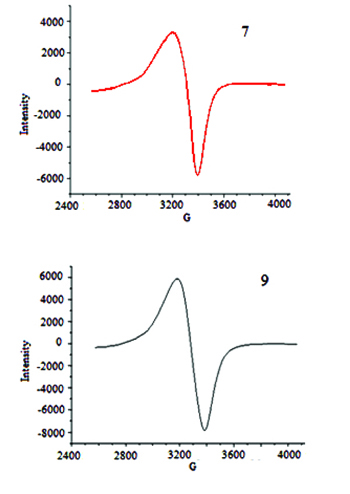 ). Analysis of spectra gives g// = 2.16 and g┴ = 2. 039 - 2. 033. The trend g// >g┴ > 2.0023 suggests dx2-y2 ground state for the Cu(II) ion, indicating that the unpaired electron is in the dx2-y2 orbital of the Cu(II) ion [14El-Boraey, H.A.; Serag El-Din, A.A. Transition metal complexes of a new 15-membered [N5] penta-azamacrocyclic ligand with their spectral and anticancer studies. Spectrochim. Acta A Mol. Biomol. Spectrosc., 2014, 132, 663-671.
). Analysis of spectra gives g// = 2.16 and g┴ = 2. 039 - 2. 033. The trend g// >g┴ > 2.0023 suggests dx2-y2 ground state for the Cu(II) ion, indicating that the unpaired electron is in the dx2-y2 orbital of the Cu(II) ion [14El-Boraey, H.A.; Serag El-Din, A.A. Transition metal complexes of a new 15-membered [N5] penta-azamacrocyclic ligand with their spectral and anticancer studies. Spectrochim. Acta A Mol. Biomol. Spectrosc., 2014, 132, 663-671.
[http://dx.doi.org/10.1016/j.saa.2014.05.018] [PMID: 24892547] , 15EL-Boraey. H.A.; EL-Gammal, O.A.; New 15-membered tetraaza (N4) macrocyclic ligand and its transition metal complexes: spectral, magnetic, thermal and anticancer activity. Spectrochim. Acta A, 2015, 138, 533-562.
[http://dx.doi.org/10.1016/j.saa.2014.11.015] , 35Shebl, M.; Khalil, S.M.E.; Al-Gohani, F.S. Preparation, spectral characterization and antimicrobial activity of binary and ternary Fe(III), Co(II), Ni(II), Cu(II), Zn(II), Ce(III) and UO2(VI) complexes of a thiocarbohydrazone ligand. J. Mol. Struct., 2010, 980, 78-87.
[http://dx.doi.org/10.1016/j.molstruc.2010.06.040] ]. The greater value of g// compared to g┴ indicates a tetragonal distortion around the Cu(II) ions [41Kavitha, N.; Anantha Lakshmi, P.V. Synthesis, characterization and thermogravimetric analysis of Co(II), Ni(II), Cu(II) and Zn(II) complexes supported by ONNO tetradentate Schiff base ligand derived from hydrazino benzoxazine. J. Saudi Chem. Soc., 2015, 21, S457-66.
[http://dx.doi.org/10.1016/j.jscs.2015.01.003] , 42Gurumoorthy, P.; Ravichandran, J.; Karthikeyan, N.; Palani, P.; Kalilur Rahiman, A. Template synthesis of polyaza macrocyclic copper(II) and nickel(II) complexes: Spectral characterization and antimicrobial studies. Bull. Korean Chem. Soc., 2012, 33(7), 2279-2286.
[http://dx.doi.org/10.5012/bkcs.2012.33.7.2279] ]. Moreover, the observed g// values ˂ 2.3 revealing an appreciable covalent nature for Cu-L bond [43Kivelson, D.; Neiman, R. ESR studies on the bonding in copper complexes. J. Chem. Phys., 1961, 35, 149-155.
[http://dx.doi.org/10.1063/1.1731880] ]. The exchange interaction between the copper centers in polycrystalline sample is explained by Hathaway expression G=g//-2.0023/g┴-2.0023 [44Hathaway, B.J.; Billing, D.E. The electronic properties and stereochemistry of mononuclear complexes of the copper(II) ion. Coord. Chem. Rev., 1970, 5, 143-207.
[http://dx.doi.org/10.1016/S0010-8545(00)80135-6] ]. The calculated G value for complexes is higher than 4 indicating no exchange interaction between copper centers.
 |
Fig. (1) EPR spectra for Cu(II) complexes (7,9). |
2.5. Thermogravimetric Studies
The thermal properties of the 16-membered N4 macrocyclic metal(II) complexes were carried out by thermogravimetric analysis (TGA/DTG) in N2 atmosphere from 25 to 800 °C, at a rate of 10 °C min-1. The obtained data are represented in Table 5.
2.5.1. Iron(II) Complex
The TG curve iron (II) complex (1) exhibits a weight loss in the temperature range of 30-80 °C associated with one DTG peak at 48 °C which is assigned to loss of solvent of crystallization. The TG/DTG curves display gradual decomposition at 272–460 °C, leaving Fe2O3, as the final product.
2.5.2. Cobalt (II) Complexes
In TG curves cobalt(II) complexes (2-4), mass loss within the temperature range 30– 97 °C, corresponding to one endothermic DTG peak at 44– 47°C, that is attributed to the loss of solvent of crystallization. The TG curves show gradual decomposition at a temperature range of 200-508 °C, remaining Co for complexes (2,3) and CoO for complex (4) as final residue.
2.5.3. Nickel (II) Complexes
For Ni(II) complexes (5,6), the TG curves show that mass loss occurs at 30– 80 °C, associated with one endothermic DTG peak at 48–56 7 °C, is corresponding to release of the solvent of crystallization in one step (Table 5). On further heating, the organic part is lost in one or more stages, with the formation of Ni for complex (5), and NiO for complex (6) as final residue.
2.5.4. Copper(II) Complexes
TG thermograms of copper(II) complexes (7-9) show a mass loss from room temperature up to 97 °C, associated with one endothermic DTG peak, that is attributed to the loss of solvent molecules (Table 5). The TG/ DTG curves also show that complexes (7,8) decomposed at 300,230 °C, respectively. The thermogram of complex (9) displayed two degradation stages. The first stage at 97-297 °C is corresponding to the loss of (NO3+OH) (weight loss; Calc./Found%; 11.47/11.8%). The next stage at 297-408 °C is attributed to the completion of the decomposition process. The final decomposition products can be CuO for complexes (7-8) and Cu for complex (9).
2.6. Kinetic Data for the Macrocyclic Complexes
The kinetic and thermodynamic parameters of the decomposition stages of the complexes (1, 4-7) were calculated from TGA thermogram using the Coats–Redfern equation [45Coats, A.W.; Redfern, J.P. Kinetic parameters from thermogravimetric data. Nature, 1964, 201, 68-122.
[http://dx.doi.org/10.1038/201068a0] ]. The Horowitz and Metzger [46Horowitz, H.H.; Metzger, G. A New analysis of thermogravimetric traces. J. Anal. Chem., 1963, 35, 1464-1468.
[http://dx.doi.org/10.1021/ac60203a013] ] equation:  was used for the evaluation of the value of the reaction order, and given by:
was used for the evaluation of the value of the reaction order, and given by:  where is the weight fraction of the substance present at DTG peak temperature Ts, is the remaining weight at Ts, and are the initial and final weights of the substance, respectively. The estimated values of for the thermal decomposition of the desolvated complexes were found in the range of 0.28-0.35 (Table 6 and Fig. 2
where is the weight fraction of the substance present at DTG peak temperature Ts, is the remaining weight at Ts, and are the initial and final weights of the substance, respectively. The estimated values of for the thermal decomposition of the desolvated complexes were found in the range of 0.28-0.35 (Table 6 and Fig. 2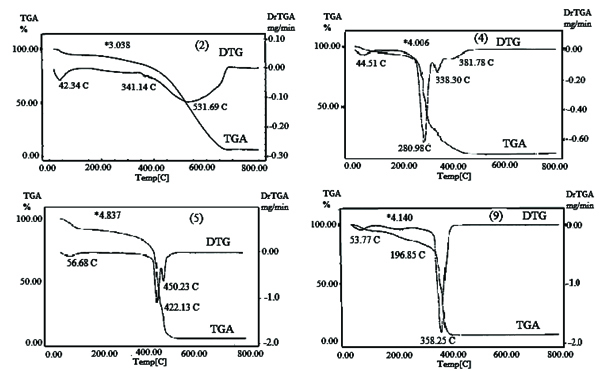 ), indicating that the degradation suggests first order reaction [14El-Boraey, H.A.; Serag El-Din, A.A. Transition metal complexes of a new 15-membered [N5] penta-azamacrocyclic ligand with their spectral and anticancer studies. Spectrochim. Acta A Mol. Biomol. Spectrosc., 2014, 132, 663-671.
), indicating that the degradation suggests first order reaction [14El-Boraey, H.A.; Serag El-Din, A.A. Transition metal complexes of a new 15-membered [N5] penta-azamacrocyclic ligand with their spectral and anticancer studies. Spectrochim. Acta A Mol. Biomol. Spectrosc., 2014, 132, 663-671.
[http://dx.doi.org/10.1016/j.saa.2014.05.018] [PMID: 24892547] , 15EL-Boraey. H.A.; EL-Gammal, O.A.; New 15-membered tetraaza (N4) macrocyclic ligand and its transition metal complexes: spectral, magnetic, thermal and anticancer activity. Spectrochim. Acta A, 2015, 138, 533-562.
[http://dx.doi.org/10.1016/j.saa.2014.11.015] ]. Thermodynamic parameters such as the activation energy E*, Arrhenius constant A, the activation entropy S*, the activation enthalpy H* and the free energy of activation G* were calculated using Coats–Redfern equation for n = 1:
 |
(1) |
 |
Fig. (2) TG/DTA curves of complexes (2,4, 5,9). |
Where: x is the fraction decomposed, R: is the gas constant and θ is the heating rate. Since (1-2RT/E*) ≈ 1, a plot of the left-hand side of Eq. (1) against 1/T gives a straight line from its slope and intercept, E* and A were determined. The entropy of activation S*, enthalpy of activation H* and Gibbs free energy G* were calculated by applying the following equations:,and .
The calculated kinetic and thermodynamic values are listed in Table 6. From the results, the values reveal high stability of the complexes. Since the positive sign of indicates that decomposition stages are endothermic processes. The reaction for which is positive and is negative reveals that the free energy of the final residue is higher than that of the initial compound, and all decomposition steps are non-spontaneous processes. On the other hand, the negative values of indicate more ordered activated complex than the corresponding reactants and that the reaction is slow [47Sivakumar, P.; Parthiban, K.S.; Sivakumar, P.; Vinoba, M.; Renganathan, S. Optimization of extraction process and kinetics of sterculia foetida Seed oil and its process augmentation for biodiesel production. Ind. Eng. Chem. Res., 2012, 52, 8992-8998.
[http://dx.doi.org/10.1021/ie300882t] ]. The correlation coefficients of the Arrhenius plots of the thermal decomposition steps were found to lie in the range 0.97 to 0. 95 showing the best fit with a linear function.
From the interpretation of elemental analyses, molar conductivity, magnetic susceptibilities, spectral and thermal studies, suggested structures for the complexes (1–11) are given in Fig. (3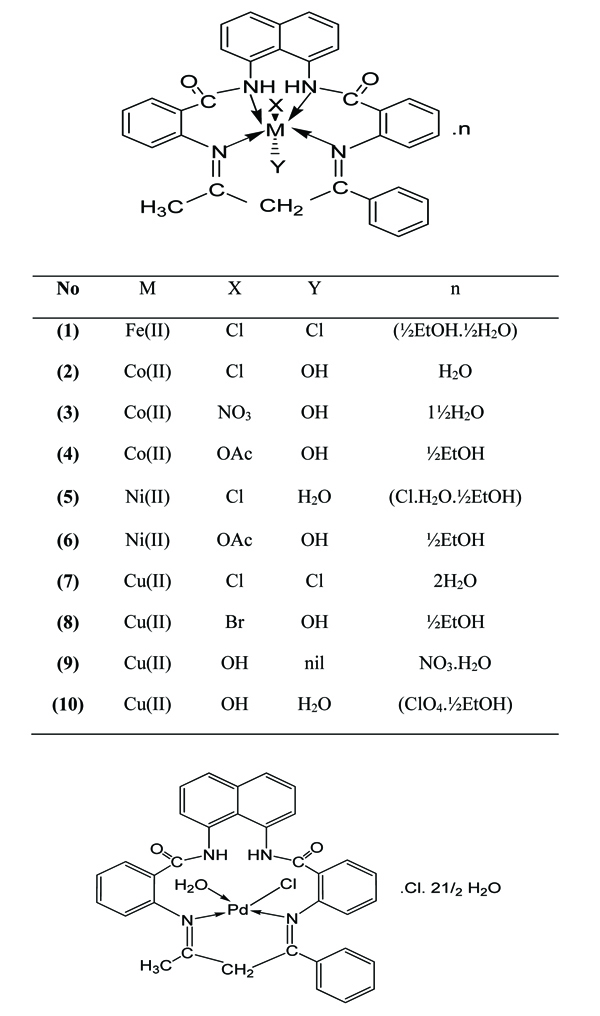 ).
).
 |
Fig. (3) Suggested structure of the macrocyclic complexes (1-11). |
2.7. Biological Results
The anticancer activity of the16-membered N4 macrocyclic metal complexes (1,2,5,7,9) was detected in vitro against human breast cancer cell (MCF-7) and human hepatocarcinoma cell (Hep-G2) by SRB assay. The results of the cytotoxic activity in vitro expressed as IC50 are given in Table 7 and plotted in (Fig. 4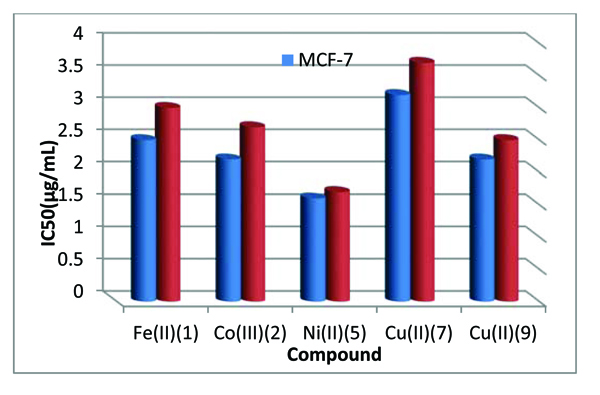 ). The tested complexes show IC50 value in the range of 3.2-1.6 and 3.7-1.7 μg/mL towards human breast cancer cell lines (MCF-7) and human hepatocarcinoma cells (Hep- G2), respectively. According to Sheir [48Shier, W.T. Mammalian cell culture on $5 a day: A laboratory manual of low cost methods., 1991, ], these complexes are considered to be very active towards the two cell lines. The results indicate that Ni(II) complex (5) showed highest cytotoxic activity on both human breast cancer cell line and hepatocarcinoma cell (IC50 value = 1.6 and 1.7 μg/mL, respectively). The enhanced activity of the investigated complexes agrees well with and better than the documented activity of similar metal complexes as antitumor agents [13EL-Boraey. H.A.; Emam, S.M.; Tolan, D.A.; El-Nahas, A.M.; Structural studies and anticancer activity of a novel (N6O4) macrocyclic ligand and its Cu(II) complexes. Spectrochim. Acta A, 2011, 78, 360-370.
). The tested complexes show IC50 value in the range of 3.2-1.6 and 3.7-1.7 μg/mL towards human breast cancer cell lines (MCF-7) and human hepatocarcinoma cells (Hep- G2), respectively. According to Sheir [48Shier, W.T. Mammalian cell culture on $5 a day: A laboratory manual of low cost methods., 1991, ], these complexes are considered to be very active towards the two cell lines. The results indicate that Ni(II) complex (5) showed highest cytotoxic activity on both human breast cancer cell line and hepatocarcinoma cell (IC50 value = 1.6 and 1.7 μg/mL, respectively). The enhanced activity of the investigated complexes agrees well with and better than the documented activity of similar metal complexes as antitumor agents [13EL-Boraey. H.A.; Emam, S.M.; Tolan, D.A.; El-Nahas, A.M.; Structural studies and anticancer activity of a novel (N6O4) macrocyclic ligand and its Cu(II) complexes. Spectrochim. Acta A, 2011, 78, 360-370.
[http://dx.doi.org/10.1016/j.saa.2010.10.021] -15EL-Boraey. H.A.; EL-Gammal, O.A.; New 15-membered tetraaza (N4) macrocyclic ligand and its transition metal complexes: spectral, magnetic, thermal and anticancer activity. Spectrochim. Acta A, 2015, 138, 533-562.
[http://dx.doi.org/10.1016/j.saa.2014.11.015] , 30Sherif, O.E.; Abdel-Kader, N.S. Spectroscopic and biological activities studies of bivalent transition metal complexes of Schiff bases derived from condensation of 1,4-phenylenediamine and benzopyrone derivatives. Spectrochim. Acta A Mol. Biomol. Spectrosc., 2014, 117, 519-526.
[http://dx.doi.org/10.1016/j.saa.2013.08.037] [PMID: 24025671] , 49Osowole, A.A.; Akpan, E.J. Synthesis, spectroscopic characterisation, In-vitro anticancer and antimicrobial activities of some metal(II) complexes of 3-{4, 6-dimethoxy pyrimidinyl) iminomethylnaphthalen-2-ol. Eur. J. Appl. Sci., 2012, 4(1), 14-20.]. The macrocycle, as well as the type of metal ions, may be the reason for their different anticancer activity. These compounds seem to be promising as an anticancer agent because of their high cytotoxic activity. The active sequence of the complexes follows the trend:
Ni(II) > Co(II) = Cu(II) NO3 > Fe(II) > Cu(II) Cl2 for MCF-7 cells;
NiII) > Cu(II) NO3 > Co(III) > Fe(II) > Cu(II)Cl2 for Hep-G2 cells
 |
Fig. (4) Lethal concentration (IC50) of the macrocyclic metal complexes on MCF-7 and Hep-G2 cell lines. |
CONCLUSION
In the present study, a new Tetraaza (N4) macrocyclic metal complexes obtained by template condensation reaction were synthesized. The structure of macrocyclic metal complexes have been proposed on the basis of the analytical data as elemental analyses, conductivity, magnetic, spectral as electronic, EPR and IR and thermal studies. The results revealed the formation of monomeric macrocyclic metal complexes. A distorted octahedral, distorted square pyramidal or square planar geometry may be proposed for these complexes. All the complexes of the tested series were potent anticancer agents.
5. EXPERIMENTAL
5.1. Materials
The metal salts (E.Merck) were commercially available as pure samples. All the chemicals used in this study were of AnalaR grade and procured from Sigma, Aldrich and Fluka. All solvents were used as received. All reactions were carried out under normal atmospheric conditions.
5.1.1. Synthesis of the Macrocyclic Complexes
The starting material, N,N'-(naphthalene-1,8-diyl)bis(2- aminobenzamide) has been synthesized and characterized as previously reported [15EL-Boraey. H.A.; EL-Gammal, O.A.; New 15-membered tetraaza (N4) macrocyclic ligand and its transition metal complexes: spectral, magnetic, thermal and anticancer activity. Spectrochim. Acta A, 2015, 138, 533-562.
[http://dx.doi.org/10.1016/j.saa.2014.11.015] ]. The macrocyclic metal complexes were synthesized by template condensation reaction as follows: 0.5 g (1mmol) of N,N'-(naphthalene-1,8-diyl)bis(2- aminobenzamide) in ethanol was refluxed with 0.2 g of 1-benzoylacetone in ethanol (1:1) molar ratio. To the above solution, 20 mL ethanolic solution of different metal salt was added. The reaction mixture was stirred under reflux whereupon the complexes precipitated. The brownish black solid precipitate formed was collected by filtration and washed several times with cold ethanol and dried under vacuum.
5.2. Physical Methods
Microanalyses (C,H and N) of these complexes were carried out at Cairo University, Giza, Egypt using CHNS- 932 (LECO) Vario Elemental Analyzer. Metal contents were estimated using standard methods [50West, T.S. Complexometry with EDTA and related reagents., (3rd ed. ), 1969, ]. The Fourier Transform Infrared (FT-IR) measurements in the range of 4000– 400 cm-1 were recorded in KBr discs using Nenexeus-Nicolidite-640-MSA FT-IR. Thermo-Electronics Co. Electronic spectra were determined in Nujol mull using 4802 UV/vis double beam spectrophotometer. The 1H NMR spectrum was recorded in DMSO- d6 using Varian Gemini 200 NMR spectrophotometer at 300 MHz. The EPR spectra were measured using a Varian E-109C model X-band spectrometer. The molar conductance was measured at 30 oC in DMSO solution (10- 3 M) using a CON 6000 conductivity meter. Magnetic measurements (Gouy balance) were carried out at room temperature. The effective magnetic moments were calculated using the relation μeff=2.828 (χmT)1/2 B.M., where χm is the molar susceptibility corrected for diamagnetism of all atoms in the compounds. The complexes were studied by thermogravimetry (TG /DTG) in a static nitrogen atmosphere with a sample heating rate of 10 oC/min, using a Shimadzu DTA/TG-50 Thermal Analyzer.
5.3. Anticancer Activity
The cytotoxicity of the compounds was tested at the National Cancer Institute, Cairo University Egypt by SRB assay using the method of Skehan et al. [51Skehan, P.; Storeng, R.; Scudiero, D.; Monks, A.; McMahon, J.; Vistica, D.; Warren, J.T.; Bokesch, H.; Kenney, S.; Boyd, M.R. New colorimetric cytotoxicity assay for anticancer-drug screening. J. Natl. Cancer Inst., 1990, 82(13), 1107-1112.
[http://dx.doi.org/10.1093/jnci/82.13.1107] [PMID: 2359136] ]. Cells were plated in 96- multiwell plate (104 cells/ well) for 24 h before treatment with the compounds to allow attachment of a cell to the wall of the plate. Different concentrations of the compound under test (0, 2.5, 5, 10, 20 μg /mL) added to the cell monolayer triplicate wells were prepared for each individual dose. Monolayer cells were incubated with the compounds for 48 h at 37 oC and an atmosphere of 5% CO2. After 48 h, cells were fixed, washed and stained with Sulfo-Rhoda- mine-B stain. Excess stain was washed with acetic acid and attached stain was recovered with Tris EDTA buffer. Color intensity was measured in an ELISA reader. The relation between surviving fraction and drug concentration is plotted to obtain the survival curve of each tumor cell line after the specified compound.
CONSENT FOR PUBLICATION
Not applicable.
CONFLICT OF INTEREST
The authors declare no conflict of interest, financial or otherwise.
ACKNOWLEDGEMENTS
Declared none.
REFERENCES
| [1] | Montero-Vázquez, E.F.; Martínez-Martínez, F.J.; Padilla-Martínez, I.I.; Carvajal-García, M.A.; Hernández-Díaz, J.H. New bis-oxalamides from trans-1,2-diaminocyclohexane. ARKOVIC (V), 2008, pp. 276-282. |
| [2] | Emara, A.A.A.; El-Sayed, B.A.; Ahmed, S.A. Syntheses, spectroscopic characterization and thermal behavior on novel binuclear transition metal complexes of hydrazones derived from 4,6-diacetylresorcinol and oxalyldihydrazine. Spectrochim. Acta A Mol. Biomol. Spectrosc., 2008, 69(3), 757-769. [http://dx.doi.org/10.1016/j.saa.2007.05.028] [PMID: 17627871] |
| [3] | Salavati-Niasari, M.; Davar, F.; Saberyan, K. Template synthesis and characterization of diaza dioxa macrocyclic nanosized cobalt(II) complex dispersed within nanocavity of zeolite-Y. Polyhedron, 2010, 29, 2149-2156. [http://dx.doi.org/10.1016/j.poly.2010.04.003] |
| [4] | Salavati-Niasari, M. Synthesis, characterization and catalytic epoxidation of styrene using molecular oxygen over “neat” and host–guest nanocomposite materials. J. Mol. Catal. Chem., 2007, 278, 22-28. [http://dx.doi.org/10.1016/j.molcata.2007.08.019] |
| [5] | Chandra, S.; Sangeetika, X. EPR, magnetic and spectral studies of copper(II) and nickel(II) complexes of schiff base macrocyclic ligand derived from thiosemicarbazide and glyoxal. Spectrochim. Acta A Mol. Biomol. Spectrosc., 2004, 60(1-2), 147-153. [http://dx.doi.org/10.1016/S1386-1425(03)00220-8] [PMID: 14670471] |
| [6] | Chandra, S.; Gupta, L.K. Mass, IR, electronic and EPR spectral studies on transition metal complexes with a new tetradentate 12-membered new macrocyclic ligand. Spectrochim. Acta A Mol. Biomol. Spectrosc., 2004, 60(13), 3079-3085. [http://dx.doi.org/10.1016/j.saa.2004.01.030] [PMID: 15477147] |
| [7] | Chandra, S.; Gupta, L.K.; Jain, D. Spectroscopic studies on Mn(II), Co(II), Ni(II), and Cu(II) complexes with N-donor tetradentate (N4) macrocyclic ligand derived from ethylcinnamate moiety. Spectrochim. Acta A Mol. Biomol. Spectrosc., 2004, 60(10), 2411-2417. [http://dx.doi.org/10.1016/j.saa.2003.12.016] [PMID: 15249033] |
| [8] | Fernández-Fernández, M.C.; Bastida, R.; Macías, A.; Valencia, L.; Pérez-Lourido, P. Different nuclearities of M(II) nitrate complexes (M = Co, Ni, Cu and Cd) with a tetrapyridyl pendant-armed hexaazamacrocyclic ligand. Polyhedron, 2006, 25, 783-792. [http://dx.doi.org/10.1016/j.poly.2005.07.045] |
| [9] | Izatt, R.M.; Bradshaw, J.S.; Nielsen, S.A.; Lamb, J.D.; Christensen, J.J.; Sen, D. Thermodynamic and kinetic data for cation-macrocycle interaction. Chem. Rev., 1985, 85, 271-339. [http://dx.doi.org/10.1021/cr00068a003] |
| [10] | Temel, H.; Ilhan, S. Prepared and characterization of new macrocyclic Schiff bases and their binuclear copper complexes. Spectrochim. Acta A Mol. Biomol. Spectrosc., 2008, 69(3), 896-903. [http://dx.doi.org/10.1016/j.saa.2007.05.041] [PMID: 17604212] |
| [11] | Chandra, S.; Gupta, L.K. EPR, IR and electronic spectral studies on Mn(II), Co(II), Ni(II) and Cu(II) complexes with a new 22-membered azamacrocyclic [N4] ligand. Spectrochim. Acta A Mol. Biomol. Spectrosc., 2004, 60(8-9), 1751-1761. [http://dx.doi.org/10.1016/j.saa.2003.07.011] [PMID: 15248947] |
| [12] | Chandra, S.; Gupta, L.K. Spectroscopic approach in characterization of chromium(III), manganese(II), iron(III) and copper(II) complexes with a nitrogen donor tetradentate, 14-membered azamacrocyclic ligand. Spectrochim. Acta A, 2005, 61, 2139-2144. [http://dx.doi.org/10.1016/j.saa.2004.06.060] |
| [13] | EL-Boraey. H.A.; Emam, S.M.; Tolan, D.A.; El-Nahas, A.M.; Structural studies and anticancer activity of a novel (N6O4) macrocyclic ligand and its Cu(II) complexes. Spectrochim. Acta A, 2011, 78, 360-370. [http://dx.doi.org/10.1016/j.saa.2010.10.021] |
| [14] | El-Boraey, H.A.; Serag El-Din, A.A. Transition metal complexes of a new 15-membered [N5] penta-azamacrocyclic ligand with their spectral and anticancer studies. Spectrochim. Acta A Mol. Biomol. Spectrosc., 2014, 132, 663-671. [http://dx.doi.org/10.1016/j.saa.2014.05.018] [PMID: 24892547] |
| [15] | EL-Boraey. H.A.; EL-Gammal, O.A.; New 15-membered tetraaza (N4) macrocyclic ligand and its transition metal complexes: spectral, magnetic, thermal and anticancer activity. Spectrochim. Acta A, 2015, 138, 533-562. [http://dx.doi.org/10.1016/j.saa.2014.11.015] |
| [16] | Harinath, Y.; Kumar Reddy, D.H.; Kumar, B.N.; Apparao, Ch.; Seshaiah, K. Synthesis, spectral characterization and antioxidant activity studies of a bidentate Schiff base, 5-methyl thiophene-2-carboxaldehyde-carbohydrazone and its Cd(II), Cu(II), Ni(II) and Zn(II) complexes. Spectrochim. Acta A Mol. Biomol. Spectrosc., 2013, 101, 264-272. [http://dx.doi.org/10.1016/j.saa.2012.09.085] [PMID: 23103468] |
| [17] | Kang, S.G.; Song, J.; Jeong, J.H. Synthesis and characterization of new unsaturated macrobicyclic and bis(macrocyclic) copper(II) complexes containing N–CH2–N linkages. Inorg. Chim. Acta, 2004, 357, 605-610. [http://dx.doi.org/10.1016/j.ica.2003.06.006] |
| [18] | Curtis, N.F. Macrocyclic coordination compounds formed by condensation of metal-amine complexes with aliphatic carbonyl compounds. Coord. Chem. Rev., 1968, 3, 3-47. [http://dx.doi.org/10.1016/S0010-8545(00)80104-6] |
| [19] | Niasari, M.S.; Daver, F. New 14-membered octaazamacrocyclic complexes: Synthesis, spectral, antibacterial and antifungal studies. Inorg. Chem. Commun., 2006, 9, 175-179. |
| [20] | Prasad, R.N.; Gupta, S.; Jangir, S. J. Indian Chem. Soc., 2007, 84, 1191-1194. |
| [21] | Khan, T.A.; Hasan, S.S.; Mohamed, A.K.; Shakir, M. Template synthesis and spectroscopic studies of 13 membered oxotetraaza macrocyclic complexes. Indian J. Chem., 1998, 37, 1123-1125. |
| [22] | El-Boraey, H.A.; El-Salamony, M.A. Hathout. A.A. Macrocyclic [N5] transition metal complexes: synthesis, characterization and biological activities. J. Incl. Phenom. Macrocycl. Chem., 2016, 86, 153-166. [http://dx.doi.org/10.1007/s10847-016-0649-5] |
| [23] | Geary, W.G. The use of conductivity measurements in organic solvents for the characterization of coordination compounds. Coord. Chem. Rev., 1971, 7, 81-122. [http://dx.doi.org/10.1016/S0010-8545(00)80009-0] |
| [24] | Kong, D.; Xie, Y. Synthesis, structural characterization of tetraazamacrocyclic ligand, five-coordinated zinc(II) complexes. Inorg. Chim. Acta, 2002, 338, 142-148. [http://dx.doi.org/10.1016/S0020-1693(02)01025-3] |
| [25] | Gupta, L.K.; Chandra, S. Spectroscopic characterization and EPR spectral studies on transition metal complexes with a novel tetradentate, 12-membered macrocyclic ligand. Spectrochim. Acta A Mol. Biomol. Spectrosc., 2006, 65(3-4), 792-796. [http://dx.doi.org/10.1016/j.saa.2005.12.042] [PMID: 16529988] |
| [26] | Keypour, H.; Arzhangi, P.; Rahpeyma, N.; Rezaeivala, M.; Elerman, Y.; Büyükgüng, O.; Valencia, L.R.; Khavasi, H. Synthesis and characterization of Ni(II), Cu(II) and Zn(II) complexes with new macrocyclic Schiff base ligands containing piperazine moiety. J.Mol. Struct., 2010, 977, 6-11. [http://dx.doi.org/10.1016/j.molstruc.2010.04.036] |
| [27] | Abou-Hussein, A.A.A.; Linert, W. Synthesis, spectroscopic and biological activities studies of acyclic and macrocyclic mono and binuclear metal complexes containing a hard-soft Schiff base. Spectrochim. Acta A Mol. Biomol. Spectrosc., 2012, 95, 596-609. [http://dx.doi.org/10.1016/j.saa.2012.04.057] [PMID: 22580137] |
| [28] | El-Boraey, H.A. Coordination behavior of tetraaza [N4] ligand towards Co(II), Ni(II), Cu(II), Cu(I) and Pd(II) complexes: Synthesis, spectroscopic characterization and anticancer activity. Spectrochim. Acta A Mol. Biomol. Spectrosc., 2012, 97, 255-262. [http://dx.doi.org/10.1016/j.saa.2012.05.077] [PMID: 22765944] |
| [29] | Swamy, S.J.; Reddy, E.R.; Raju, D.N.; Jyothi, S. Synthesis and spectral investigations of manganese(II), cobalt(II), nickel(II), copper(II) and zinc(II) complexes of new polydentate ligands containing a 1,8-naphthyridine moiety. Molecules, 2006, 11(12), 1000-1008. [http://dx.doi.org/10.3390/11121000] [PMID: 18007404] |
| [30] | Sherif, O.E.; Abdel-Kader, N.S. Spectroscopic and biological activities studies of bivalent transition metal complexes of Schiff bases derived from condensation of 1,4-phenylenediamine and benzopyrone derivatives. Spectrochim. Acta A Mol. Biomol. Spectrosc., 2014, 117, 519-526. [http://dx.doi.org/10.1016/j.saa.2013.08.037] [PMID: 24025671] |
| [31] | Soliman, A.A.; Amin, M.A.; El-Sherif, A.A.; Ozdemir, S.; Varlikli, C.; Zafer, C. Synthesis and characterization of novel series of Fe(II)-mixed ligand complexes involving 2,20-bipyridyl ligand. Dyes Pigments, 2013, 99, 1056-1064. [http://dx.doi.org/10.1016/j.dyepig.2013.08.007] |
| [32] | Ray, U.; Banerjee, D.; Liou, J.C.; Lin, C.N.; Lu, T.H.; Sinha, C. Iron(II) and nickel(II)-thiocyanato complexes of 1-alkyl-2-(arylazo)imidazole: single crystal X-ray structure of [Fe(MeaaiEt)2(NCS)2] (MeaaiEt = 1-ethyl-2(p-tolylazo)imidazole) and [Ni(MeaaiMe)(NCS)2(H2O)2] · 2DMF (MeaaiMe = 1-methyl-2(p-tolylazo)imidazole). Inorg. Chim. Acta, 2005, 358, 1019-1026. [http://dx.doi.org/10.1016/j.ica.2004.11.020] |
| [33] | Shakir, M.; Abbasi, A.; Azam, M.; Khan, A.U. Synthesis, spectroscopic studies and crystal structure of the Schiff base ligand L derived from condensation of 2-thiophenecarboxaldehyde and 3,3′-diaminobenzidine and its complexes with Co(II), Ni(II), Cu(II), Cd(II) and Hg(II): Comparative DNA binding studies of L and its Co(II), Ni(II) and Cu(II) complexes. Spectrochim. Acta A Mol. Biomol. Spectrosc., 2011, 79(5), 1866-1875. [http://dx.doi.org/10.1016/j.saa.2011.05.077] [PMID: 21715221] |
| [34] | El-Gammal, O.A.; Bekheit, M.M.; El-Brashy, S.A. Synthesis, characterization and in vitro antimicrobial studies of Co(II), Ni(II) and Cu(II) complexes derived from macrocyclic compartmental ligand. Spectrochim. Acta A Mol. Biomol. Spectrosc., 2015, 137, 207-219. [http://dx.doi.org/10.1016/j.saa.2014.08.016] [PMID: 25218230] |
| [35] | Shebl, M.; Khalil, S.M.E.; Al-Gohani, F.S. Preparation, spectral characterization and antimicrobial activity of binary and ternary Fe(III), Co(II), Ni(II), Cu(II), Zn(II), Ce(III) and UO2(VI) complexes of a thiocarbohydrazone ligand. J. Mol. Struct., 2010, 980, 78-87. [http://dx.doi.org/10.1016/j.molstruc.2010.06.040] |
| [36] | Ilhan, S.H. Temel, Synthesis and spectral studies of macrocyclic Cu(II), Ni(II) and Co(II) complexes by template reaction of 1,4-bis(3-aminopropoxy)butane with metal(II) nitrate and salicylaldehyde derivatives. J. Mol. Struct., 2008, 891, 157-166. [http://dx.doi.org/10.1016/j.molstruc.2008.03.016] |
| [37] | Mohamed, G.G.; Ibrahim, N.A.; Attia, H.A.E. Synthesis and anti-fungicidal activity of some transition metal complexes with benzimidazole dithiocarbamate ligand. Spectrochim. Acta A Mol. Biomol. Spectrosc., 2009, 72(3), 610-615. [http://dx.doi.org/10.1016/j.saa.2008.10.051] [PMID: 19119060] |
| [38] | El-Boraey, H.A.; Serag El-Din, A.A.; El Sayed, I. New complexes with 19-membered pyridine-based macrocycle ligand Synthesis, characterization, thermal and in vitro anticancer activity. J. Therm. Anal. Calorim., 2017, 129(2), 1243-53. [http://dx.doi.org/10.1007/s10973-017-6169-8] |
| [39] | Geeta, B.; Shravankumar, K.; Reddy, P.M.; Ravikrishna, E.; Sarangapani, M.; Reddy, K.K.; Ravinder, V. Binuclear cobalt(II), nickel(II), Copper(II) and Palladium(II) complexes of a new Schiff-base as ligand: Synthesis, structural characterization, and antibacterial activity. Spectrochim. Acta A Mol. Biomol. Spectrosc., 2010, 77(4), 911-915. [http://dx.doi.org/10.1016/j.saa.2010.08.004] [PMID: 20801709] |
| [40] | Chandra, S.; Raizada, S.; Rani, S. Structural and spectral studies of palladium(II) and platinum(II) complexes derived from N,N,N,N-tetradentate macrocyclic ligands. Spectrochim. Acta A Mol. Biomol. Spectrosc., 2008, 71(2), 720-724. [http://dx.doi.org/10.1016/j.saa.2007.12.051] [PMID: 18343190] |
| [41] | Kavitha, N.; Anantha Lakshmi, P.V. Synthesis, characterization and thermogravimetric analysis of Co(II), Ni(II), Cu(II) and Zn(II) complexes supported by ONNO tetradentate Schiff base ligand derived from hydrazino benzoxazine. J. Saudi Chem. Soc., 2015, 21, S457-66. [http://dx.doi.org/10.1016/j.jscs.2015.01.003] |
| [42] | Gurumoorthy, P.; Ravichandran, J.; Karthikeyan, N.; Palani, P.; Kalilur Rahiman, A. Template synthesis of polyaza macrocyclic copper(II) and nickel(II) complexes: Spectral characterization and antimicrobial studies. Bull. Korean Chem. Soc., 2012, 33(7), 2279-2286. [http://dx.doi.org/10.5012/bkcs.2012.33.7.2279] |
| [43] | Kivelson, D.; Neiman, R. ESR studies on the bonding in copper complexes. J. Chem. Phys., 1961, 35, 149-155. [http://dx.doi.org/10.1063/1.1731880] |
| [44] | Hathaway, B.J.; Billing, D.E. The electronic properties and stereochemistry of mononuclear complexes of the copper(II) ion. Coord. Chem. Rev., 1970, 5, 143-207. [http://dx.doi.org/10.1016/S0010-8545(00)80135-6] |
| [45] | Coats, A.W.; Redfern, J.P. Kinetic parameters from thermogravimetric data. Nature, 1964, 201, 68-122. [http://dx.doi.org/10.1038/201068a0] |
| [46] | Horowitz, H.H.; Metzger, G. A New analysis of thermogravimetric traces. J. Anal. Chem., 1963, 35, 1464-1468. [http://dx.doi.org/10.1021/ac60203a013] |
| [47] | Sivakumar, P.; Parthiban, K.S.; Sivakumar, P.; Vinoba, M.; Renganathan, S. Optimization of extraction process and kinetics of sterculia foetida Seed oil and its process augmentation for biodiesel production. Ind. Eng. Chem. Res., 2012, 52, 8992-8998. [http://dx.doi.org/10.1021/ie300882t] |
| [48] | Shier, W.T. Mammalian cell culture on $5 a day: A laboratory manual of low cost methods., 1991, |
| [49] | Osowole, A.A.; Akpan, E.J. Synthesis, spectroscopic characterisation, In-vitro anticancer and antimicrobial activities of some metal(II) complexes of 3-{4, 6-dimethoxy pyrimidinyl) iminomethylnaphthalen-2-ol. Eur. J. Appl. Sci., 2012, 4(1), 14-20. |
| [50] | West, T.S. Complexometry with EDTA and related reagents., (3rd ed. ), 1969, |
| [51] | Skehan, P.; Storeng, R.; Scudiero, D.; Monks, A.; McMahon, J.; Vistica, D.; Warren, J.T.; Bokesch, H.; Kenney, S.; Boyd, M.R. New colorimetric cytotoxicity assay for anticancer-drug screening. J. Natl. Cancer Inst., 1990, 82(13), 1107-1112. [http://dx.doi.org/10.1093/jnci/82.13.1107] [PMID: 2359136] |




